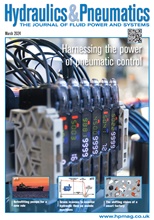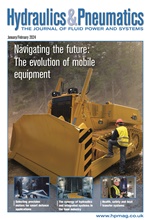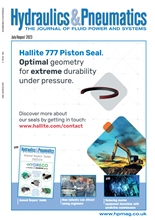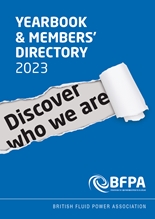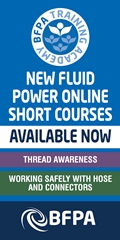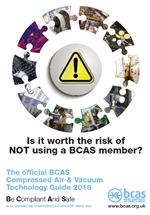- Home » Editorial » Hydraulics
Getting the best out of particle monitoring
By Mike Day, managing director, CMS Consultants Ltd.
It is now widely accepted that the presence of particles within hydraulic fluid is one of the main causes of failure, unreliability and short component life in hydraulic systems – whether they be fluid power, lubrication or fuel.
Most industries now utilise processes that are designed to achieve and maintain fluid cleanliness; that is to say, many companies are now effectively managing cleanliness rather than simply struggling to control contamination.
Three of the main aspects critical to managing cleanliness are: the setting of the appropriate cleanliness level for each system, a means of promptly measuring the cleanliness level and a maintenance regime that is capable of immediately responding to an out-of-specification incident to restore the status quo. Let’s consider the impact of these aspects in more detail:
System cleanliness specification
This is really where cleanliness management starts. The required cleanliness level (RCL) for the system should be based upon the contaminant sensitivity of the components and the life and reliability required by the operator. Thus, it is an individual concept. The RCL also dictates the cleanliness level that has to be achieved in the production and assembly processes.
In the past, this could be something of a ‘black art’ and the RCL was selected on a somewhat ad-hoc basis rather than using technology. This was recognised by the British Fluid Power Association (BFPA), which developed a comprehensive method based upon the system requirements. This has recently been accepted as ISO 12669:2017 [1]. It allows operators not only to set the RCL to suit their specific requirements but to also check whether the RCL they are using is the best possible.
System cleanliness monitoring techniques
In the April 2016 edition of Hydraulics & Pneumatics, I explained the philosophy of cleanliness management of hydraulic systems and how this was best served by permanently fitting an on-line automatic particle counter/monitor (APC). A typical example is MP Filtri's ICM in-line automatic particle counter.
These units have greatly improved the accuracy of data now that the errors associated with bottle sampling [2] are eliminated, and give data ‘immediately’; thus, any detrimental change in cleanliness can be promptly detected and rectified. However, this improved accuracy does create some challenges – created mainly by the improvement in system cleanliness brought about by better system management over the past decade or so [3]:
• The perception of what RCL is best and what is clean or dirty was formed ‘years ago’ when analysis was via sample bottles. This process made the sample appear to be dirtier than it was in the system. Most of these RCLs are not appropriate for modern systems and requirements. It is therefore sensible to review the RCL you use so that it truly reflects your requirements? Remember that a two-fold increase in the contamination code could be a four-fold increase in the dirt generation rate.
• When APCs are fitted to systems, the system cleanliness levels they measure surprises a lot of people and their immediate reaction is that the APC is reading incorrectly. Well it is that clean and has been so for a while; it is only with these APCs that we are able to truly measure these levels.
• Another remark is that “it does not have to be that clean”. On hearing this, I cite a quote by the late John Spencer of Vickers Systems (now Eaton Corp.) in 1981: “No system has failed because the oil was too clean.”
• Finally, the low particle counts magnify any changes in the system particle generation rate du to operation, although their magnitude is relatively small, the proportionate increase may be large and ‘alarming’.
Managing cleanliness
The requirements to successfully manage system cleanliness are stated in the opening paragraph; any impediment caused by the above ‘challenges’ can be partially resolved by acquiring more knowledge about the use and application of on-line APCs. This is best achieved by forming a partnership with the manufacturer of the APC rather than ad-hoc on the job learning by trial and error.
The manufacturer will, or should, provide full training on the both the principal of the APC and also its operation, especially in relation to its scope and application, and perhaps tailor the configuration to the application. Experience has shown that this aspect can take a considerable amount of time, so it is not unreasonable for the manufacturer to make a nominal charge for this service. This should be viewed as an investment as it will save the operator a considerable amount of time in the long run and enable the operator to get the best out of the installation.
Conclusion
The use of online APCs can greatly enhance the efficiency of maintenance regimes. In the past, RCLs were mainly founded on experiences with bottle samples. It should also be pointed out that although the costs of some types of APC are considered falsely by some to be prohibitive, these units are in fact relatively inexpensive. So, with today’s affordable, state-of-the-art instruments and ISO 12669:2017, companies should certainly look to review their RCLs.
References:
[1] ISO 12669:2017 Hydraulic fluid power – Guidelines for determining the required cleanliness level (RCL) of a system, International Standards Org., Geneva, Switzerland.
[2] M J Day & J Rinkinen: ‘Contaminant monitoring of hydraulic systems – the need for reliable data’, presented at COMADEN 97, Tampere University of Technology, Tampere, Finland.
[3] M. J. Day & C.Galletly: ‘Reducing the lifecycle costs of marine systems by fluid cleanliness management.’, presented at ‘Tribology At Sea’, University of Southampton, 28th June 2006, I Mech E , June 2006.
-
Smart Manufacturing & Engineering Week
05 - 06 June, 2024
NEC, Birmingham -
HILLHEAD 2024
25 June, 2024, 9:00 - 27 June, 2024, 16:00
Hillhead Quarry, Buxton, Derbyshire UK



